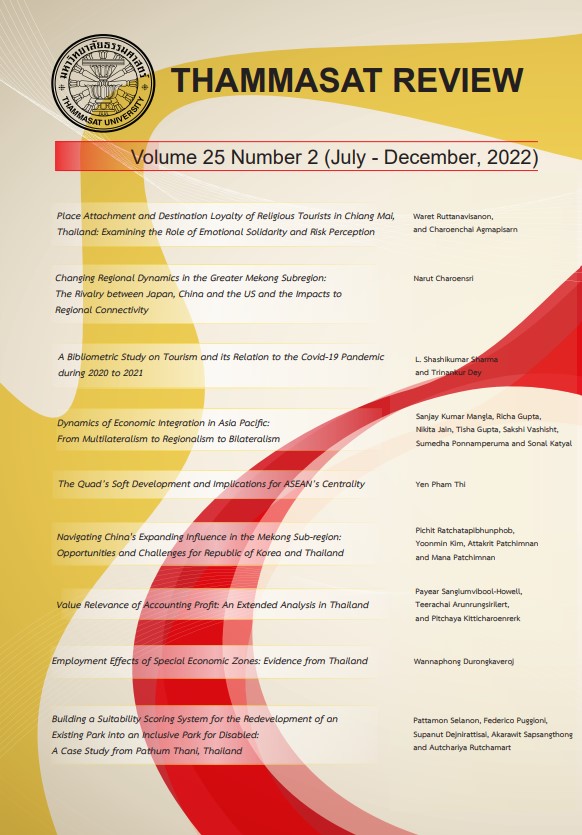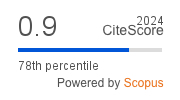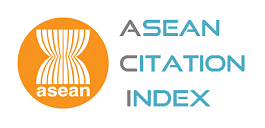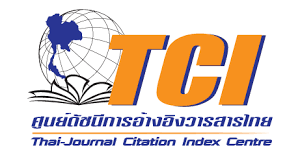Navigating China's Expanding Influence in the Mekong Sub-region: Opportunities and Challenges for Republic of Korea and Thailand
Keywords:
Keywords: Greater Mekong Sub-region; Thailand; Republic of Korea; Gravity modelAbstract
This paper examines the impact of regional economic cooperation between Thailand, the Republic of Korea, and partner countries, focusing on the efficiency of the Greater Mekong Sub-region (GMS) cooperation. Overall, we find that the GMS takes a noteworthy part in Thailand and the Republic of Korea’s economic portfolios. We apply the gravity model of international trade associated with random-effect method to predict multilateral trade investment and finance cooperation. We found significant interaction terms between trade openness and financial development in GMS cooperation. In other words, while trade openness can facilitate the Republic of Korea’s and Thailand’s exports of goods and services, financial coordination becomes more improved. These results indicate key relationship factors that can facilitate efficiency of GMS cooperation. However, Thailand and the Republic of Korea need to move forward to facilitate some vital policy implications in the context of greater benefits from GMS economic cooperation, especially on trade liberalization associated with economic reform programs and financial development.
References
Attakrit, P. & Bhathorn S. (2020). Research projects on the impacts and approaches to revitalize commercial economy from the COVID-19 crisis [Unpublished Research]. International Institute for Trade and Development.
Banomyong, R. (2010). Benchmarking economic corridors logistics performance: A GMS border crossing observation. World Customs Journal, 4(1), 29-38.
Branchoux, C., Fang, L., & Tateno, Y. (2018). Estimating Infrastructure Financing Needs in the Asia-Pacific Least Developed Countries, Landlocked Developing Countries, and Small Island Developing States. Economies, 6(43), 1-21.
Han, P., Meas, S., & Hatda P. (2021). Understanding Quality Energy-Related Infrastructure Development in the Mekong Subregion: Key Drivers and Policy Implications. Economic Research Institute for ASEAN and East Asia. http://hdl.handle.net/11540/ 13358.
Hiep, N. L. (2020). Economic Cooperation in the Greater Mekong Sub-Region. Journal of Economic Integration, 35(2), 240-263.
Ishida, M. (2005). Effectiveness and challenges of three economic corridors of the Greater Mekong Sub-region. Discussion Paper No.35. Institute of Developing Economies (IDE-JETRO).
Kaewkitipong, L. & Brown D. (2008). Adoption and evaluation of e-business in Thai SMEs: A process perspective, Conference Proceeding, learning from the past & charting the future of the discipline. 14th Americas Conference on Information Systems, AMCIS. Toronto, Ontario, Canada; 2008.
Brown, D. H., & Kaewkitipong, L. (2009). Relative size and complexity: e‐business use in small and medium sized tourism enterprises in Thailand. Journal of Enterprise Information Management, 22(1/2), 212-231.
Kiatipong, A. (2015, June 1). The economic destiny of Thailand and the GMS: what is the right financial sector model? Bangkok Post. https://www.bangkokpost.com/ business/578815/
Kim, J. H. (2013). Transboundary water issue: The case of hydropower in the Mekong river basin. Water for future, 46(6), 28-33.
Kwak, S. (2021). Shinnambang Jeongchaeeui Bijeonkwa Dojeon Korean [Korea's New Southern Policy: Vision and Challenges]. Sejong: Korea Institute for International Economic Policy.
Kwak, S. (2018). Korea's New Southern Policy: Vision and Challenges.
Lee, G., & Scurrah, N. (2009). Power and Responsibility: The Mekong River Commission and Lower Mekong Mainstream Dams. Australian Mekong Resource Center, (University of Sydney and Oxfam Australia).
Lee, G., & Natalia. S. (2008). The Governance Role of the MRC vis-a-vis Mekong Mainstream Dams.
Lu, G. (2012). China’s Entry into the Mekong River Commission, Advantages and Disadvantages? The World Knowledge.
Medhi, K. (2004). The development of the Greater Mekong Subregion (GMS): real promise or false hope? Journal of Asian Economics, 15(5), 977-998.
Nisit, P., & Chukiat, C. (2020). China's Outward Foreign Direct Investment in the Greater Mekong Subregion. Journal of Economic Integration, 35(1), 129-151.
Oehlers, A. (2006). A critique of ADB policies towards the Greater Mekong Sub-region. Journal of Contemporary Asia, 36(4), 464-478.
Open Development Mekong. (2022, November 30), https://opendevelopmentmekong.net
Siriluk, M. (2004). Sino-Thai Strategic Economic Development in the Greater Mekong Subregion (1992-2003), Contemporary Southeast Asia, 26(2), 302-19.
Sohn, C. H. (2005). Does the gravity model explain south Korea’s trade flows? Japanese Economic Review, 56(4), 417–430.
The Federation of Korean Industries [FKI]. (2022). FKI Database. https://www.koisra.co.kr/ news/fki-the-federation-of-korean-industries/
Than, M. (19970. Economic Co-operation in the Greater Mekong Subregion. Asian Pacific Economic Literature, 11(2), 40-57.
Zeitoun, M., & Warner, J. (2006). Hydro-hegemony–a framework for analysis of trans-boundary water conflicts. Water policy, 8(5), 435-460.
Zhu, Z. (2010). Mekong development and China’s (Yunan) participation in the Greater Mekong Subregion Cooperation. Ritsumeikan International Affairs, 11(8),1-16.
Downloads
Published
How to Cite
Issue
Section
License
Copyright (c) 2022 Thammasat Review

This work is licensed under a Creative Commons Attribution-NonCommercial-NoDerivatives 4.0 International License.
The opinions and ideas expressed in all submissions published in Thammasat Review are solely that of the author(s) and do not necessarily reflect that of the editors or the editorial board.
The copyright of all articles including all written content and illustrations belong to Thammasat Review. Any individuals or organisation wishing to publish, reproduce and distribute a particular manuscript must seek permission from the journal first.








